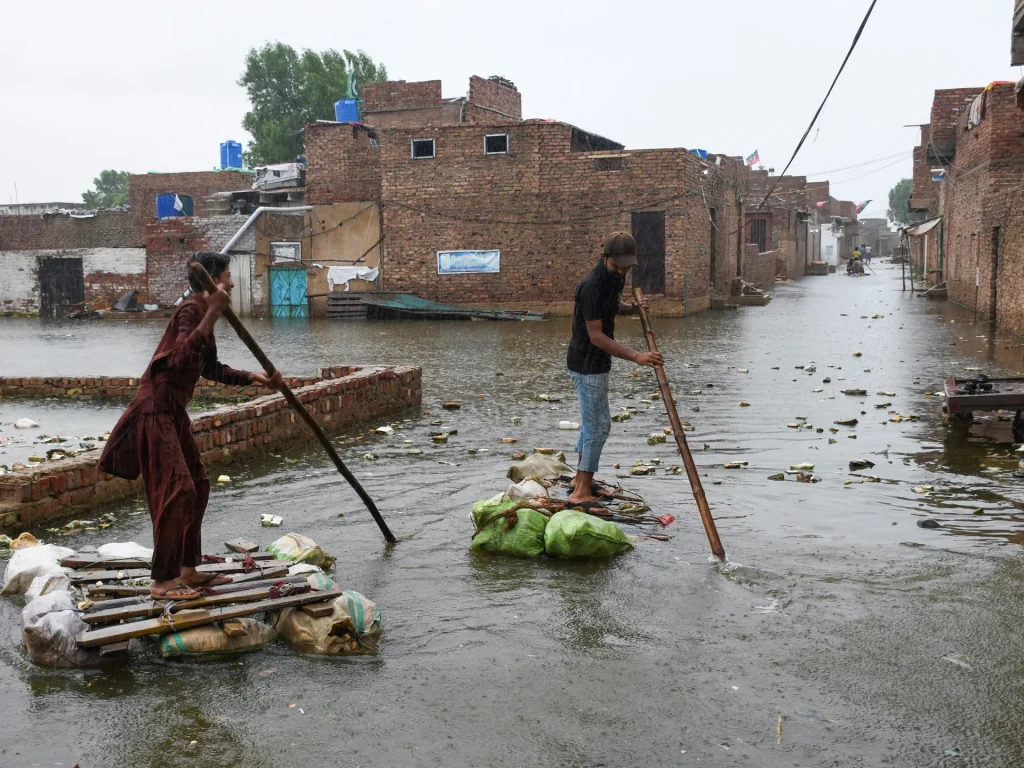The Pakistan monsoon floods have unleashed one of the deadliest rainy seasons in recent years, submerging vast regions and devastating communities across the country. Relentless rains, overflowing rivers, and flash floods continue to wreak havoc, claiming lives and displacing thousands.
According to the National Disaster Management Authority (NDMA), at least 657 people have died since June 26. More than 920 others have been injured as downpours triggered house collapses, lightning strikes, and landslides. The Pakistan monsoon floods have affected nearly every province, but Khyber Pakhtunkhwa (KP) has emerged as the hardest hit.
Remote districts in KP, particularly Buner, have become the epicenter of the crisis. Rescue 1122 officials revealed that they have already recovered 373 bodies from across the province, with most casualties reported in Buner. “The Rescue 1122 has recovered 373 bodies from all flood-affected districts of KP till Sunday. Rescue and search operations are still underway,” said spokesperson Bilal Ahmad Faizi.
Fresh downpours on Monday worsened the suffering. Heavy showers lashed Mardan, while Nowshera recorded thunderous rainfall across multiple areas. In Swabi, floodwaters entered homes and shops. Swat’s Mingora city saw life come to a halt after torrential rain, while Malakand also reported widespread flooding.
In Buner, volunteers struggled to deliver aid as a temporary bridge connecting a stranded village risked collapse. In Parachinar, flash floods swelled the Kurram River, damaging embankments and cutting off roads. Although no casualties were reported, restoration work was ongoing. Meanwhile, in Nowshera’s Chakki Mamrez area, a roof collapse during the rains killed a husband and wife.
Peshawar, the provincial capital, suffered severe urban flooding after continuous showers since Sunday night. Overflowing drains submerged Saddar Bazaar, University Road, Bara Road, Gulbahar, Kotla Mohsin Khan, Phando, Zaryab Colony, Gulberg, Fakirabad, Pajjagi Road, Hayatabad, and Shaheedabad. Streets turned into rivers, traffic was paralysed, and vehicles were left stranded. Water also flooded the Western Police Station and nearby homes.
In Punjab, heavy rain lashed Multan, Kabirwala, Jhang, and Khushab, providing relief from heat but drowning low-lying neighborhoods. In Chakwal, Wahali Zair recorded 25mm of rain, Choa Saidan Shah 67mm, Lillandi 11mm, and Kusk 35mm. Bhakkar and Miani also reported swamped streets after hours of continuous rain.
Quetta and other districts of Balochistan remained cloudy and humid. The Met Office forecast rain in Zhob, Musakhail, Mastung, Loralai, Kohlu, Kalat, Barkhan, and Sibi, while scattered showers were expected in Dera Bugti, Nasirabad, Khuzdar, Awaran, Ormara, Pasni, and Lasbela. In Azad Kashmir, thunderstorms struck Dhirkot and several parts of Poonch division.
Rivers and Dams Under Pressure
The Pakistan monsoon floods have put rivers and reservoirs under strain. Authorities issued flood warnings along the Indus River. Medium flood levels were reported at Kalabagh, Jinnah Barrage, and Chashma Barrage in Mianwali. At Jinnah Barrage, inflows stood at 439,586 cusecs, while outflows were recorded at 422,586 cusecs. Chashma Barrage reported 483,512 cusecs inflow and 466,312 cusecs outflow. Evacuation orders were issued for riverbank settlements.
In Kot Addu, the Indus at Taunsa Barrage recorded medium flood levels with inflows of 454,356 cusecs and outflows of 453,856 cusecs. The Flood Forecasting Division confirmed that Tarbela, Kalabagh, Chashma, and Taunsa are all facing medium flood levels, while Guddu Barrage is in low flood. The Sutlej River has also entered low flood stages at Head Sulemanki and Ganda Singh Wala.
Reservoirs are filling rapidly. Tarbela Dam has reached 97% of its capacity at 1,546.60 feet, while Mangla Dam is 71% full at 1,213 feet. Water flows in the Kabul River at Nowshera and the Jhelum and Chenab rivers remain normal. Minor low floods persist in tributaries of the Ravi, including Nullah Aik and Nullah Dek. The Nari River in Sibi and hill torrents in Dera Ghazi Khan and Rajanpur are also flowing normally.
Rising Death Toll
The NDMA confirmed that of the 657 nationwide deaths, 171 were children, 94 women, and 392 men. KP alone recorded 390 deaths, with 288 men, 59 children, and 43 women among the victims. Punjab has lost 164 lives, including 70 children, 63 men, and 31 women. Sindh has reported 28 deaths, half of them children. In Balochistan, 20 people have died, most of them children. Gilgit-Baltistan has lost 32 lives, while Azad Kashmir reported 15 fatalities and Islamabad Capital Territory eight.
NDMA officials said they are working with provincial governments to scale up rescue and relief operations in the worst-affected districts. Lieutenant General Inam Haider, Chairman of NDMA, warned of more dangers ahead. “The intensity of this year’s monsoon is 50% to 60% higher than last year. Two to three more monsoon spells are expected until early September,” he cautioned in Islamabad.
Climate Change Impact
Experts say the Pakistan monsoon floods are part of a dangerous pattern of extreme weather. Landslides, flash floods, and cloudbursts are now recurring features of the season, which begins in June and ends by September. The rains bring nearly 75% of South Asia’s annual water, critical for farming and food security, but they also unleash massive destruction.
Zaheer Babar, Pakistan’s chief meteorologist, said the frequency and intensity of such extreme events are increasing. He explained that heavy rains in the mountains often trigger deadly flash floods downstream, overwhelming communities in low-lying areas. He linked climate change as a major driver but also blamed human practices. Unchecked construction along rivers, narrowed waterways, and garbage dumping restrict the natural flow of rainwater, worsening destruction.
Pakistan remains one of the most climate-vulnerable nations in the world. The 2022 Pakistan monsoon floods submerged nearly a third of the country and killed about 1,700 people. This year’s devastation again highlights the growing challenge the nation faces against climate change and poor infrastructure planning.


